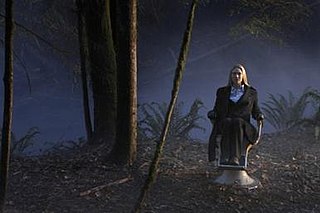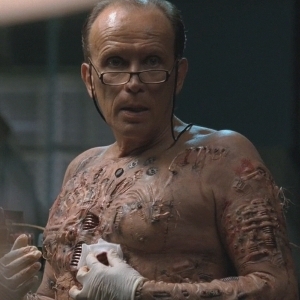
Walter Harold Bishop, Ph.D. is a fictional character on the Fox television series Fringe. He is portrayed by John Noble. Noble also plays Walter's counterpart in the show's parallel universe, who is referred to in the show as Walternate.

"The Arrival" is the fourth episode of the first season of the American science fiction drama television series Fringe. The episode was written by the series co-creator and executive producer J. J. Abrams and executive producer and show runner Jeff Pinkner. Paul A. Edwards directed it.
"The Same Old Story" is the second episode of the first season of the American science fiction drama television series Fringe. The episode was written by executive producer Jeff Pinkner and co-creators J. J. Abrams, Alex Kurtzman, and Roberto Orci. When developing the series, they sought to find a medium between serialized drama and the crime procedural. "The Same Old Story" was the first regular episode of Fringe, and journalists viewed it as an example of what they could expect from the series. It was directed by Paul A. Edwards.
"The Equation" is the eighth episode of the first season of the American science fiction drama television series Fringe. The episode follows the Fringe team's investigation into the kidnapping of a young musical prodigy who has become obsessed with finishing one piece of music. Dr. Walter Bishop returns to St. Claire's Hospital in an effort to find the boy's whereabouts.

"The Dreamscape" is the ninth episode of the first season of the American science fiction drama television series Fringe. It centers on a Fringe investigation of a Massive Dynamic employee who, after believing himself to be under attack by a swarm of sharp-winged butterflies, jumps out of a window. Meanwhile, Olivia continues her visions of the deceased John Scott, and discovers how he is related to a deadly psychoactive drug synthesized by Massive Dynamic.

The second season of the American science fiction television series Fringe commenced airing on the Fox network on September 17, 2009, and concluded on May 20, 2010. The season was produced by Bad Robot in association with Warner Bros. Television, and its showrunners were Jeff Pinkner and J. H. Wyman. Actors Anna Torv, John Noble, and Joshua Jackson reprised their roles as FBI agent Olivia Dunham and father-son duo Walter and Peter Bishop, respectively. Previous series regulars Lance Reddick, Jasika Nicole, Blair Brown, and Kirk Acevedo also returned, though with Acevedo in a limited capacity.
"The Bishop Revival" is the 14th episode of the second season of the American science fiction drama television series Fringe. The episode's storyline followed Nazi scientist Alfred Hoffman as he specially designed airborne toxins to kill only surrounding people with similar genetic traits, such as people with brown eyes.

"Jacksonville" is the 14th episode of the second season of the American science fiction drama television series Fringe, and the 35th episode overall. In the episode, Olivia is forced to recount her time spent as a child in tests conducted by Walter to regain the ability to see objects that have been influenced by the parallel universe and prevent the deaths of innocents. Though successful, Olivia comes to learn the truth about Peter, that he is from the parallel universe.

"Brown Betty" is the 19th episode of the second season of the American science fiction drama television series Fringe, the 40th overall episode of the series, and is the only one of the series performed as a musical. The episode was written by co-showrunners Jeff Pinkner and J. H. Wyman, and consulting producer Akiva Goldsman. It was directed by filmmaker Seith Mann. As the episode begins with Peter's continued disappearance, Walter consoles himself by smoking a strain of marijuana called "Brown Betty." Most of the episode is then told from his drug-addled perspective, in which Olivia is a 1940s noir detective and Peter is a conman who ran away with Walter's glass heart.

"White Tulip" is the 18th episode of the second season of the American science fiction drama television series Fringe. It follows a scientist in his quest to time travel back and save his fiancée, while the Fringe team investigates the consequences of his actions, and Walter struggles to tell his son Peter he was stolen from the parallel universe as a boy.
"The Road Not Taken" is the nineteenth episode of the first season of the American science fiction drama television series Fringe. It centers on the death of a young woman, who spontaneously combusts in the middle of a street. The Fringe team's investigation leads them to learn more about the drug trials Olivia experienced as a child, as well as other revelations.

"Grey Matters" is the 10th episode of the second season of the American science fiction drama television series Fringe. The episode was written by Ashley Edward Miller and Zack Stentz, and directed by Jeannot Szwarc. It centered on three mental patients who mysteriously became sane again after shapeshifters from the parallel universe removed a piece of foreign tissue from each of their brains; this tissue is later revealed to have been taken from the brain of Walter Bishop years before. The fringe team of Olivia Dunham, Peter Bishop, and Walter investigate and face a new enemy, Thomas Jerome Newton, whose purpose is to decipher the missing parts of Walter's brain and find out how to move between universes.

"What Lies Below" is the 12th episode of the second season of the American science fiction drama television series Fringe. Set in a quarantined Boston office building, the episode revolves around a thousands-year-old viral hemorrhagic fever that infects and then influences its victims to attempt to spread the viral particles outside of the building.
"A New Day in the Old Town" is the season premiere and first episode of the second season of the American science fiction drama television series Fringe, and the 21st episode overall. It was co-written by J. J. Abrams and Akiva Goldsman, with Goldsman directing. The episode followed the aftermath of Olivia's journey to the parallel universe in the last season's finale, while also introducing the idea of shapeshifters. It guest-starred actors Luke Goss, Ari Graynor, Meghan Markle, and Tegan Moss.

"Night of Desirable Objects" is the second episode of the second season of the American science fiction drama television series Fringe. The episode followed Olivia and Peter's investigation into mysterious disappearances taking place in a small Pennsylvania town.

"Fracture" is the third episode of the second season of the American science fiction drama television series Fringe. The episode followed the Fringe team's investigation into a man who mysteriously hardens and then explodes, killing those around him. The case leads them to a secret government project and an AWOL colonel.

"Dream Logic" is the fifth episode of the second season of the American science fiction drama television series Fringe, and the 25th episode overall. It was written by Josh Singer and directed by Paul A. Edwards. The episode follows several people seemingly dreaming while still awake, leading the Fringe team to investigate the dangerous side effects of a sleep study.

"Snakehead" is the ninth episode of the second season of the American science fiction drama television series Fringe. The episode followed the Fringe team's investigation into horrible deaths caused by large parasitic worms erupting from their victims' mouths. The case soon leads them to a Chinese gang and a black market of immunodeficiency medicinal drugs.
"The Man from the Other Side" is the 18th episode of the second season of the American science fiction drama television series Fringe. The episode follows the attempts of Thomas Jerome Newton, with the help of shapeshifters, to create a pathway between the two parallel universes, while the Fringe team's Olivia Dunham, Peter Bishop, and Walter Bishop try to stop him.
"Subject 9" is the fourth episode of the fourth season of the Fox science fiction drama television series Fringe, and the series' 69th episode overall.














